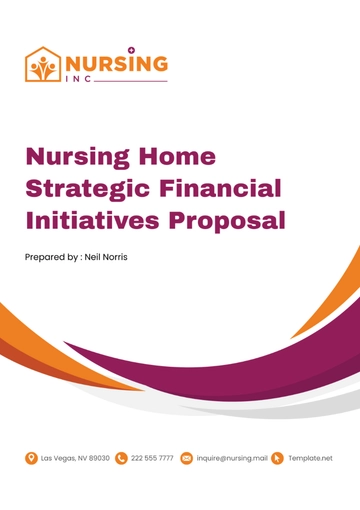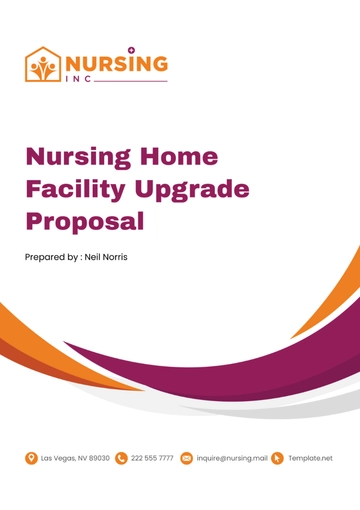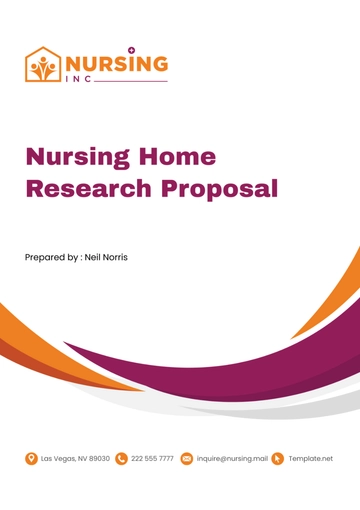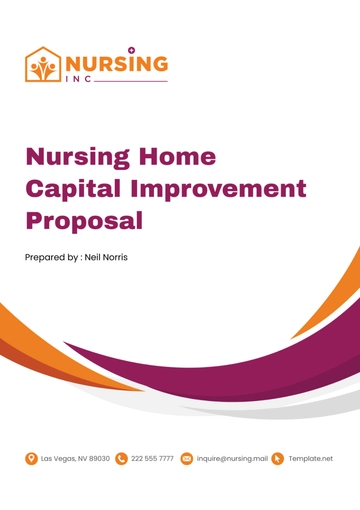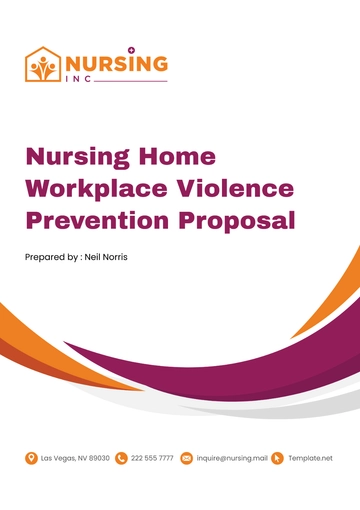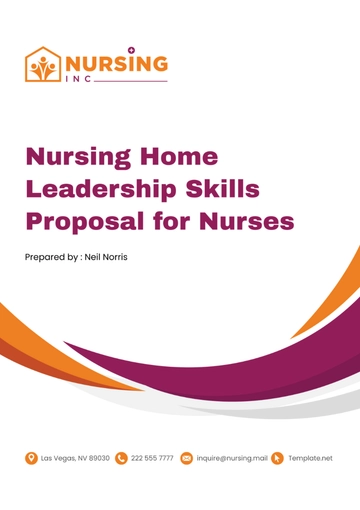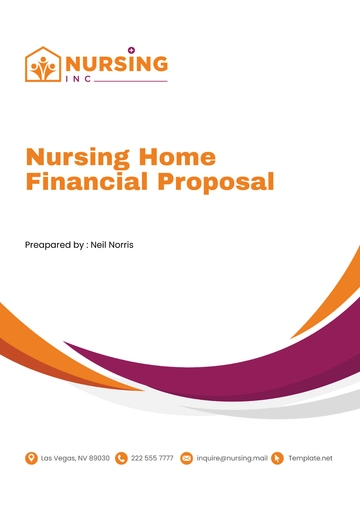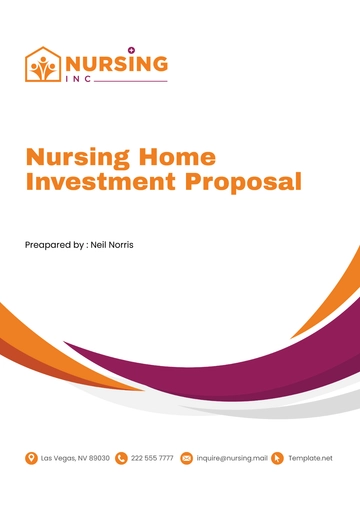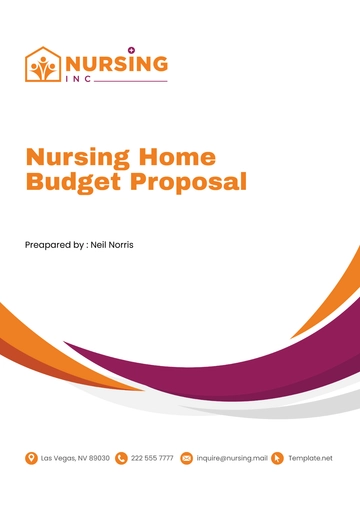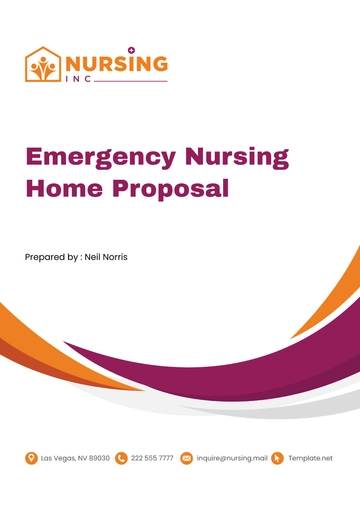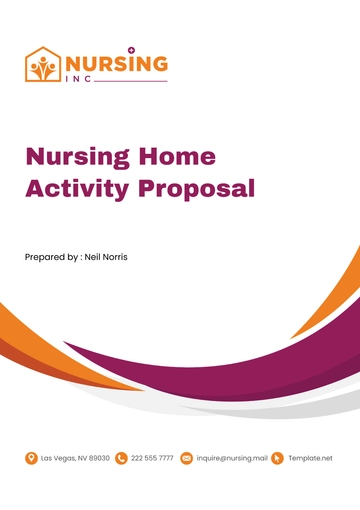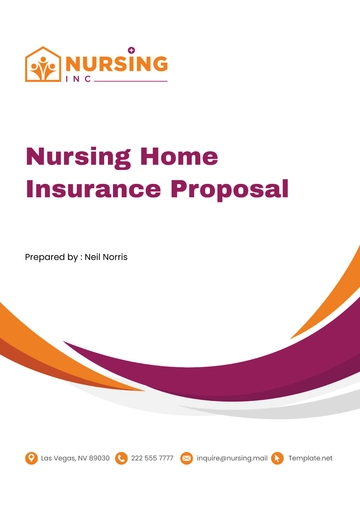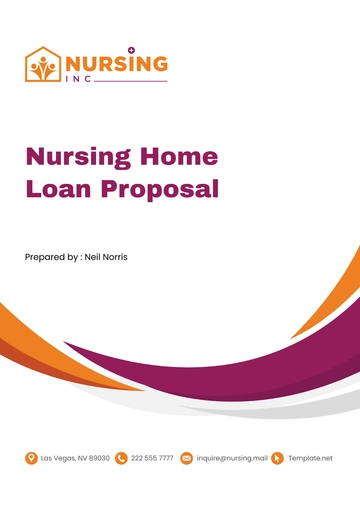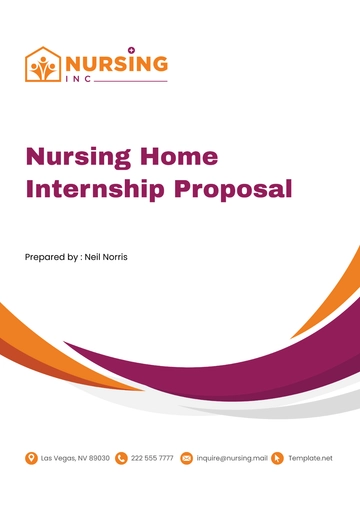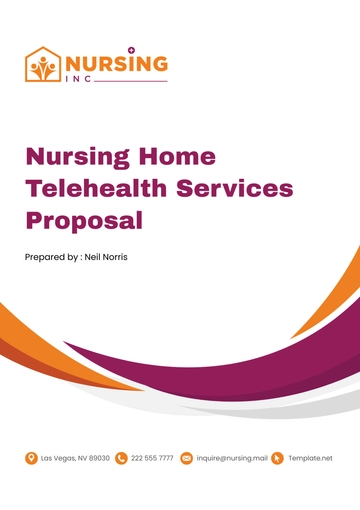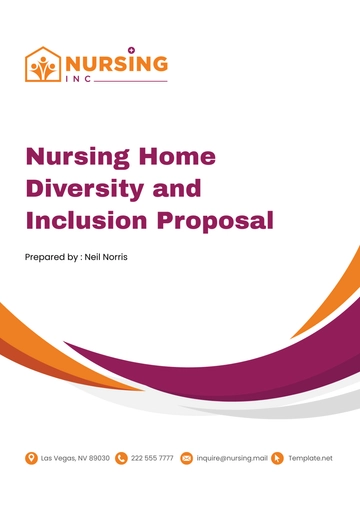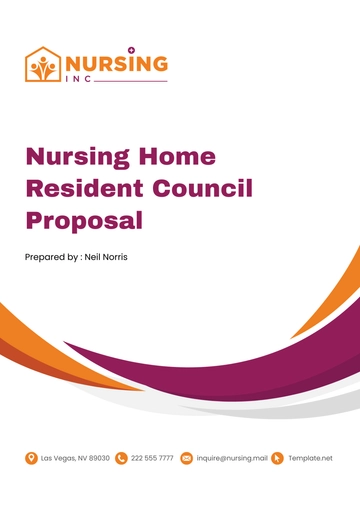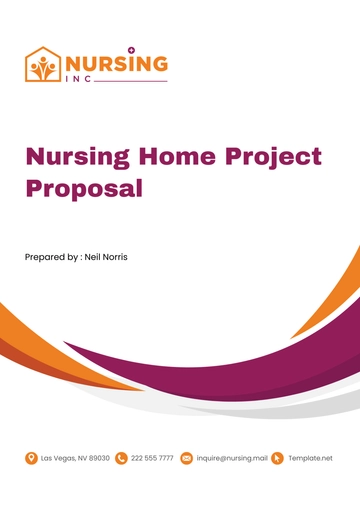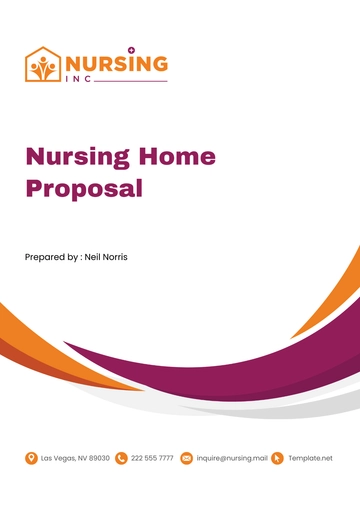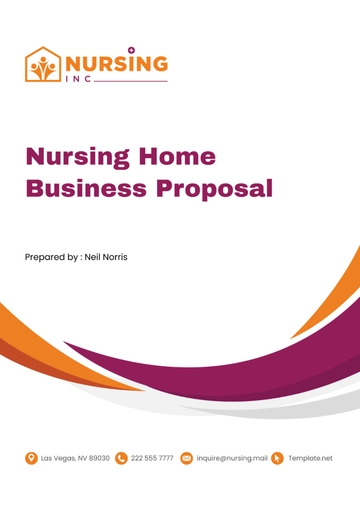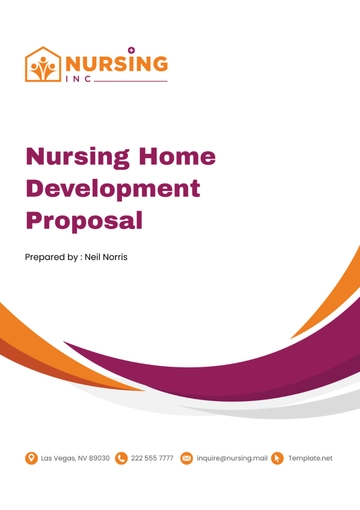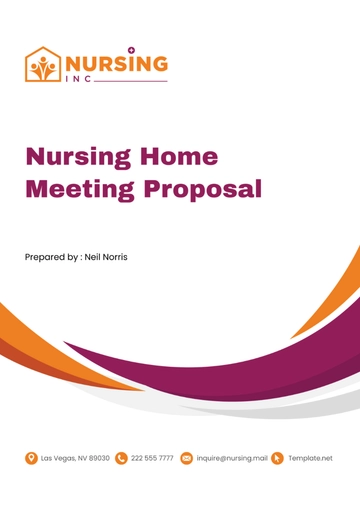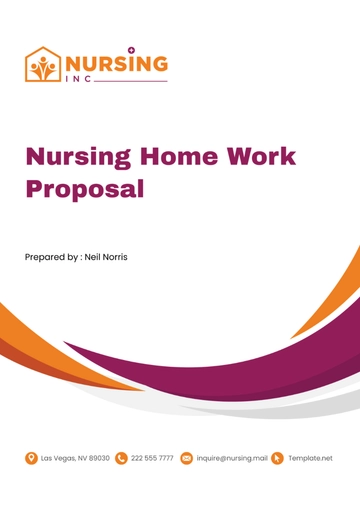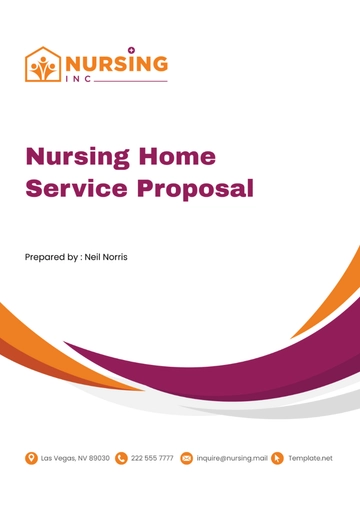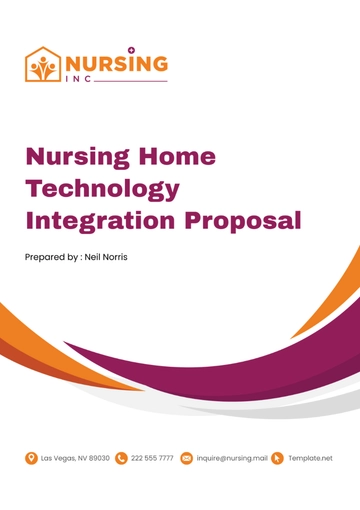Free Nursing Home Proposal
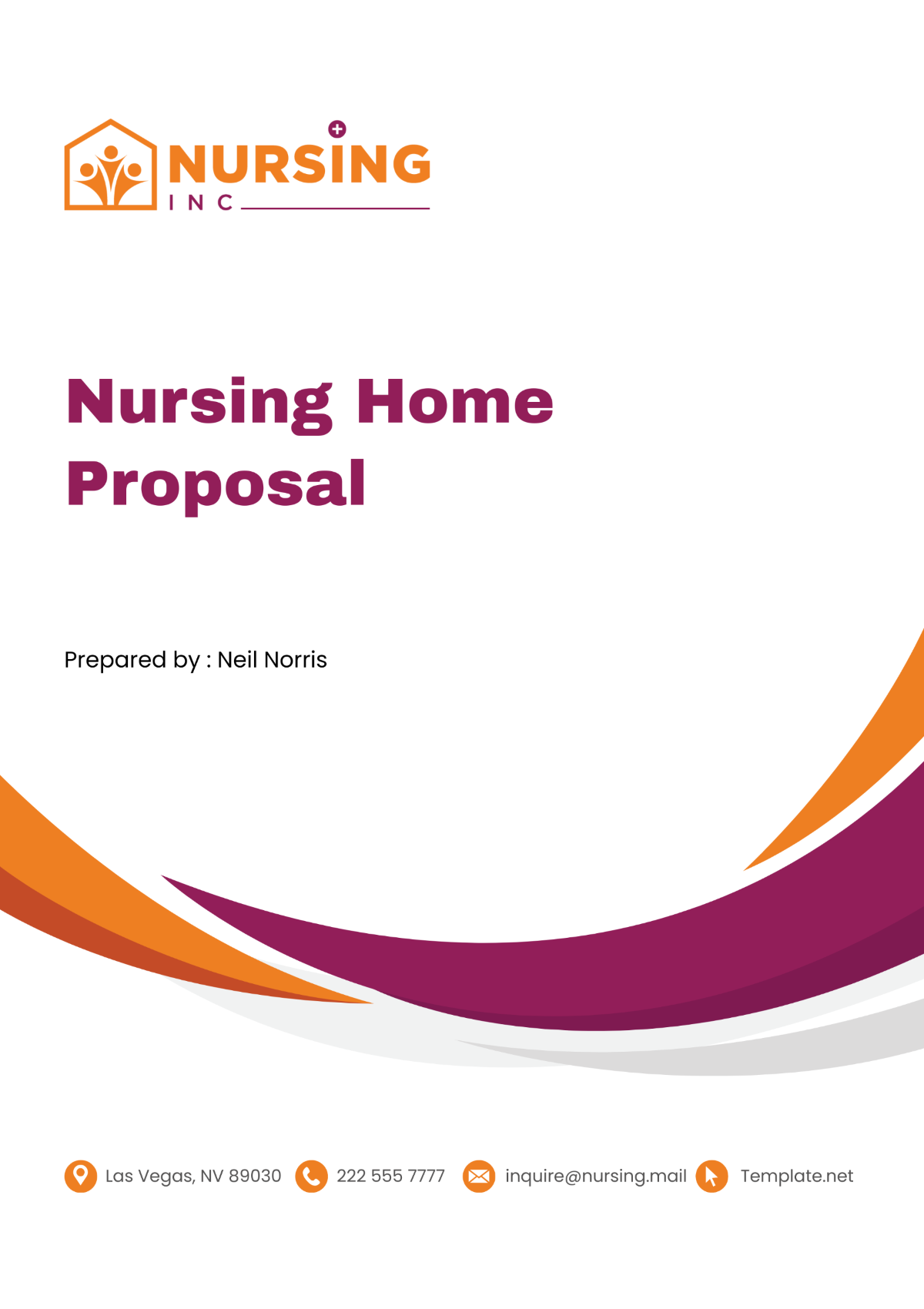
I. Executive Summary
A. Introduction
[Your Company Name] is pleased to present this comprehensive proposal for the establishment of a high-quality nursing home facility in [Location]. With the aging population on the rise, there is an urgent need to provide specialized care and support services for elderly individuals in our community. Our proposal outlines a holistic approach to address this need, focusing on delivering compassionate care, promoting independence, and enhancing quality of life for our residents.
B. Objectives
The primary objectives of this proposal are:
To provide comprehensive and compassionate care to elderly residents, ensuring their physical, emotional, and social well-being.
To create a safe and comfortable living environment that fosters dignity, respect, and autonomy for all residents.
To offer a wide range of services, including medical care, rehabilitation, recreational activities, and social engagement opportunities, tailored to meet the diverse needs and preferences of our residents.
C. Key Highlights
[Your Company Name] brings [15 years] of expertise and proven success in operating healthcare facilities, with a strong commitment to excellence in care delivery.
Our proposed nursing home facility will be designed and equipped to the highest standards, featuring modern amenities, advanced medical technology, and a warm, inviting atmosphere.
We are dedicated to upholding all regulatory requirements and industry standards, ensuring the safety, security, and well-being of our residents at all times.
D. Financial Summary
Initial investment: [$5,000,000]
Projected revenue: [$3,500,000] annually
Break-even point: [Month/Year]
Our financial projections indicate a sound investment opportunity with a projected return on investment within [5 years]. By carefully managing expenses and maximizing revenue streams, we aim to achieve sustainable profitability while maintaining affordability for our residents.
II. Introduction
A. Background
Overview of the current challenges faced by the elderly population in accessing quality care.
The demographic landscape of [Location] is rapidly evolving, with a significant increase in the proportion of elderly individuals aged 65 and older.
Existing healthcare infrastructure may be insufficient to meet the growing demand for specialized services, leading to gaps in care and limited accessibility for elderly residents.
Many elderly individuals require tailored support and assistance due to chronic illnesses, disabilities, cognitive impairments, or other age-related conditions, necessitating specialized care settings such as nursing homes.
Statistics on the aging population and the increasing demand for nursing home services.
According to [Local Health Department], the population of individuals aged 65 and older in [Location] is projected to double over the next [10 years], highlighting the pressing need for expanded eldercare options.
[30%] of elderly individuals in the area require assistance with activities of daily living, such as bathing, dressing, and medication management, indicating a significant need for supportive care services.
[40%] of elderly residents in [Location] have been diagnosed with Alzheimer's disease or other forms of dementia, underscoring the need for specialized memory care programs and facilities to meet their unique needs.
The need for specialized care facilities to address the unique needs of elderly residents.
While traditional healthcare settings may provide essential medical services, they may lack the comprehensive support and personalized attention required to optimize the health and well-being of elderly individuals.
Nursing homes play a vital role in filling this gap by offering round-the-clock care, rehabilitation services, social activities, and emotional support in a home-like environment, tailored to meet the individual needs and preferences of each resident.
B. Purpose of Proposal
To propose the establishment of a nursing home facility to meet the growing demand for elderly care in [Location].
To outline the scope and objectives of the proposed nursing home project, emphasizing our commitment to excellence in care delivery, resident-centered services, and community engagement.
To seek approval and support from stakeholders, including government agencies, healthcare providers, community organizations, and potential residents and their families, for the implementation of the nursing home facility.
III. Needs Assessment
A. Demographic Analysis
Demographic Factor | Statistics |
|---|---|
Population of Elderly | The population of individuals aged 65 and older in [Location] is rapidly increasing, with a projected doubling over the next [10 years]. |
According to [Local Health Department], there are currently [800] elderly residents in [Location]. | |
[25%] of the elderly population in [Location] require assistance with activities of daily living. | |
Prevalence of Chronic Illnesses | [35%] of elderly residents in [Location] have been diagnosed with chronic illnesses, such as hypertension, diabetes, and arthritis. |
[5%] of elderly individuals require ongoing medical management for multiple chronic conditions. |
B. Gap Analysis
Aspect | Current Status | Identified Gaps |
|---|---|---|
Existing Nursing Home Facilities | Limited availability due to high occupancy rates. | Insufficient capacity to meet the growing demand. |
Varied quality of care across facilities. | Inconsistencies in care standards and service offerings. | |
Limited specialized care options, especially for dementia patients. | Lack of dedicated memory care units or programs. | |
Access to Healthcare Services | Limited accessibility for elderly individuals with mobility issues. | Insufficient transportation services for medical appointments. |
Long wait times for appointments with primary care physicians. | Difficulty accessing timely medical care, leading to health complications. |
C. Stakeholder Consultation
During stakeholder consultations, [Your Company Name] engaged with various parties, including healthcare professionals, community leaders, potential residents, and their families, to gather insights and feedback on the proposed nursing home project. Key findings from these consultations include:
Healthcare professionals emphasized the need for expanded eldercare options and expressed support for the proposed nursing home facility.
Community leaders highlighted the economic and social benefits of establishing a nursing home in [Location].
Potential residents and their families expressed interest in the availability of personalized care plans, recreational activities, and social engagement opportunities within the facility.
IV. Proposed Solution
A. Facility Design and Features
[Your Company Name] proposes to design and construct a state-of-the-art nursing home facility that prioritizes the comfort, safety, and well-being of its residents. Key features of the facility include:
Spacious and comfortable resident rooms equipped with modern amenities, including adjustable beds, accessible bathrooms, and personal storage space.
Common areas for socialization and recreation, such as dining halls, lounges, and outdoor gardens.
Dedicated therapy rooms for physical, occupational, and speech therapy sessions.
Specialized memory care units with secure access and calming environments for residents with dementia or cognitive impairments.
24/7 security and monitoring systems to ensure the safety and security of residents and staff.
Accessibility features, including ramps, handrails, and wheelchair-friendly pathways, to accommodate residents with mobility impairments.
B. Services Offered
[Your Company Name] is committed to providing a comprehensive range of services to meet the diverse needs and preferences of our residents. Our services include:
Skilled nursing care provided by licensed healthcare professionals, including registered nurses, licensed practical nurses, and certified nursing assistants.
Personalized care plans tailored to the individual needs and preferences of each resident, incorporating medical, social, and emotional support.
Rehabilitation services, including physical therapy, occupational therapy, and speech therapy, to promote recovery and improve functional abilities.
Medication management and coordination of medical appointments to ensure timely access to healthcare services.
Recreational activities and social programs designed to promote socialization, mental stimulation, and overall well-being.
End-of-life care and support for residents and their families, delivered with compassion, dignity, and respect.
C. Staffing Plan
[Your Company Name] will implement a staffing plan to ensure the delivery of high-quality care and services to our residents. Our staffing plan includes:
Recruitment of qualified healthcare professionals, including registered nurses, licensed practical nurses, certified nursing assistants, therapists, and support staff.
Ongoing training and professional development opportunities for staff to enhance their skills, knowledge, and competencies.
Implementation of staffing ratios and schedules to ensure adequate coverage and personalized attention for residents, including 24/7 nursing coverage.
Adoption of person-centered care approaches to empower staff to build meaningful relationships with residents and provide individualized care and support.
D. Regulatory Compliance
[Your Company Name] is committed to complying with all regulatory requirements and standards to ensure the highest quality of care and safety for our residents. Our regulatory compliance efforts include:
Obtaining all necessary licenses and permits from regulatory authorities, including state health departments and licensing agencies.
Adhering to federal, state, and local regulations governing nursing home facilities, including standards for staffing, resident care, safety, and infection control.
Implementing policies and procedures to ensure compliance with industry best practices, guidelines, and accreditation standards, such as those established by the Centers for Medicare & Medicaid Services (CMS) and the Joint Commission.
Conducting regular audits, inspections, and quality assurance reviews to monitor compliance with regulatory requirements and identify areas for continuous improvement.
V. Implementation Plan
A. Timeline
Phase | Activities | Timeline |
|---|---|---|
Phase 1: Pre-construction | Site selection and acquisition. | [Month/Year] - [Month/Year] |
Feasibility studies and market analysis. | [Month/Year] - [Month/Year] | |
Phase 2: Construction | Architectural design and engineering. | [Month/Year] - [Month/Year] |
Permitting and regulatory approvals. | [Month/Year] - [Month/Year] | |
Groundbreaking and commencement of construction. | [Month/Year] - [Month/Year] | |
Phase 3: Interior | Interior construction and fit-out. | [Month/Year] - [Month/Year] |
Installation of equipment and furnishings. | [Month/Year] - [Month/Year] | |
Phase 4: Pre-launch | Staff recruitment and training. | [Month/Year] - [Month/Year] |
Marketing and promotional activities. | [Month/Year] - [Month/Year] | |
Preparing for regulatory inspections and certifications. | [Month/Year] - [Month/Year] | |
Phase 5: Launch | Grand opening and resident move-in. | [Month/Year] |
Commencement of operations and services. | [Month/Year] |
B. Resource Allocation
Resource | Allocation |
|---|---|
Financial Resources | Initial investment of [$5,000,000] for construction, equipment, and start-up costs. |
Ongoing operating budget of [$100,000] per month for staffing, utilities, and maintenance. | |
Personnel | Recruitment of [50] full-time staff members, including healthcare professionals, support staff, and administrative personnel. |
Training and professional development programs for staff to enhance skills and competencies. | |
Equipment | Procurement of medical equipment, furnishings, and technology systems for the nursing home facility. |
Installation of safety and security systems, including surveillance cameras, emergency call systems, and fire alarms. |
C. Risk Management
Risk | Mitigation Strategies |
|---|---|
Regulatory Compliance | Regular monitoring of changes in regulations and standards. |
Ongoing staff training and education on compliance requirements. | |
Financial Sustainability | Conducting thorough financial analyses and budget projections. |
Diversifying revenue streams and exploring funding opportunities. | |
Construction Delays | Establishing clear timelines and milestones for construction. |
Identifying backup suppliers and contractors for critical tasks. | |
Staff Turnover | Implementing competitive compensation and benefits packages. |
Providing ongoing support, recognition, and career advancement opportunities for staff. |
VI. Evaluation and Monitoring
A. Performance Metrics
[Your Company Name] will utilize a variety of performance metrics to evaluate the success and effectiveness of the nursing home facility. Key performance indicators (KPIs) include:
Resident Satisfaction: Regular surveys and feedback mechanisms to assess resident satisfaction with care, services, and overall quality of life.
Occupancy Rates: Monitoring of occupancy levels to ensure optimal utilization of facility resources and capacity.
Clinical Outcomes: Tracking of clinical indicators, such as medication adherence, fall rates, and hospital readmission rates, to measure health outcomes and quality of care.
Financial Performance: Analysis of revenue streams, expenses, and profitability to ensure financial sustainability and viability.
Staff Engagement: Surveys and assessments to gauge staff satisfaction, retention rates, and engagement levels, as well as staff-to-resident ratios to ensure adequate staffing levels.
Regulatory Compliance: Regular audits, inspections, and reviews to ensure compliance with regulatory requirements and accreditation standards.
B. Quality Improvement Initiatives
[Your Company Name] is committed to continuous quality improvement (CQI) to enhance the quality of care and services provided to our residents. Our quality improvement initiatives include:
Quality Assurance Program: Regular audits, assessments, and reviews of care processes, documentation, and outcomes to identify areas for improvement and implement corrective actions.
Resident Care Committees: Establishment of resident and family advisory committees to provide feedback, input, and suggestions for enhancing care and services.
Staff Training and Development: Ongoing education and training programs for staff to stay updated on best practices, evidence-based guidelines, and emerging trends in eldercare.
Incident Reporting and Analysis: Prompt investigation and analysis of adverse events, incidents, and complaints to identify root causes and implement preventive measures.
Benchmarking and Peer Comparison: Benchmarking performance against industry standards, peer facilities, and best-in-class organizations to identify opportunities for improvement and innovation.
VII. Conclusion
A. Summary of Proposal
[Your Company Name] is excited to present this comprehensive proposal for the establishment of a high-quality nursing home facility in [Location]. Through our commitment to excellence in care, state-of-the-art facilities, and person-centered approach, we aim to meet the growing demand for specialized eldercare services in the community. Our proposal outlines a holistic solution to address the unique needs and preferences of elderly residents, promoting dignity, independence, and quality of life.
B. Next Steps
We invite stakeholders, including government agencies, healthcare providers, community organizations, and potential residents and their families, to collaborate with us in bringing this project to fruition. Together, we can work towards creating a nurturing and supportive environment where elderly individuals can thrive and live their best lives. We welcome further discussion, feedback, and support as we move forward with the implementation of the nursing home facility.
- 100% Customizable, free editor
- Access 1 Million+ Templates, photo’s & graphics
- Download or share as a template
- Click and replace photos, graphics, text, backgrounds
- Resize, crop, AI write & more
- Access advanced editor
Craft compelling proposals for nursing home services with the Nursing Home Proposal Template from Template.net. This editable and customizable template outlines your offerings, expertise, and pricing structure, impressing potential clients and stakeholders. Tailor it effortlessly using our Ai Editor Tool for personalized proposals. Stand out in the market and win new business with this comprehensive template.
You may also like
- Business Proposal
- Research Proposal
- Proposal Request
- Project Proposal
- Grant Proposal
- Photography Proposal
- Job Proposal
- Budget Proposal
- Marketing Proposal
- Branding Proposal
- Advertising Proposal
- Sales Proposal
- Startup Proposal
- Event Proposal
- Creative Proposal
- Restaurant Proposal
- Blank Proposal
- One Page Proposal
- Proposal Report
- IT Proposal
- Non Profit Proposal
- Training Proposal
- Construction Proposal
- School Proposal
- Cleaning Proposal
- Contract Proposal
- HR Proposal
- Travel Agency Proposal
- Small Business Proposal
- Investment Proposal
- Bid Proposal
- Retail Business Proposal
- Sponsorship Proposal
- Academic Proposal
- Partnership Proposal
- Work Proposal
- Agency Proposal
- University Proposal
- Accounting Proposal
- Real Estate Proposal
- Hotel Proposal
- Product Proposal
- Advertising Agency Proposal
- Development Proposal
- Loan Proposal
- Website Proposal
- Nursing Home Proposal
- Financial Proposal
- Salon Proposal
- Freelancer Proposal
- Funding Proposal
- Work from Home Proposal
- Company Proposal
- Consulting Proposal
- Educational Proposal
- Construction Bid Proposal
- Interior Design Proposal
- New Product Proposal
- Sports Proposal
- Corporate Proposal
- Food Proposal
- Property Proposal
- Maintenance Proposal
- Purchase Proposal
- Rental Proposal
- Recruitment Proposal
- Social Media Proposal
- Travel Proposal
- Trip Proposal
- Software Proposal
- Conference Proposal
- Graphic Design Proposal
- Law Firm Proposal
- Medical Proposal
- Music Proposal
- Pricing Proposal
- SEO Proposal
- Strategy Proposal
- Technical Proposal
- Coaching Proposal
- Ecommerce Proposal
- Fundraising Proposal
- Landscaping Proposal
- Charity Proposal
- Contractor Proposal
- Exhibition Proposal
- Art Proposal
- Mobile Proposal
- Equipment Proposal
- Student Proposal
- Engineering Proposal
- Business Proposal
